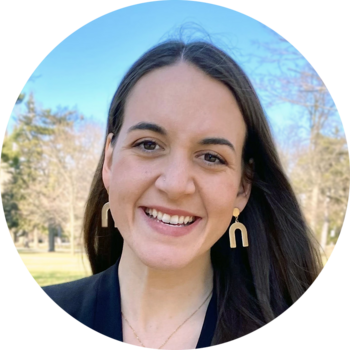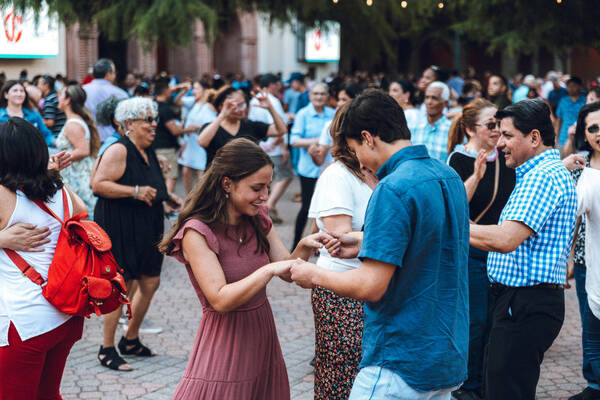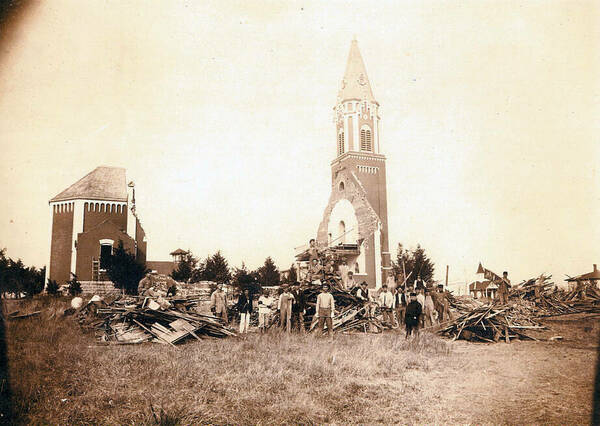
Katherine Mascari is a second year MTS student in moral theology at the University of Notre Dame and a graduate research assistant at the Cushwa Center for the Study of American Catholicism. Prior to enrolling in the M.T.S. Program, she earned her M.A. in theology through Notre Dame’s Echo Program. In summer 2023, she conducted ethnographic research focused on two parishes in north Texas as a way to consider questions of Catholic social teaching and moral formation in contemporary parish life. In fall 2023, she enrolled in a class offered by Todd Whitmore, Theological Ethnography and the Parish, where she is placing her research in conversation with other studies of parish life, moral formation, sociology, and ecclesiology.
Shane Ulbrich: Let’s start before summer 2023: What prompted you to undertake this sort of project?
Katherine Mascari: In many ways, this project felt like a chance to follow up on a number of questions that arose during my ministry in the Echo Program, motivating me to study moral theology through the M.T.S. Program at Notre Dame. During the two-year Echo Program, I was placed in the Archdiocese of Newark, New Jersey, to serve as a youth minister and faith formation assistant at a suburban parish. My transition from parish life in Texas to New Jersey in August 2020—amid a pandemic and election season—opened my eyes to the ways social contexts influence parish engagement and vice versa. I saw the ways the social, economic, and political realities “outside” the parish inevitably found expression within it, and my work in ministry often entailed implicit responses to these tensions that influenced the ways parishioners understood the intersection between theology and their everyday lives. Whether it was masking policies for ministry events, current issue topics for youth nights, service opportunities for Confirmation candidates, or the Prayers of the Faithful during Mass, the parish’s practices communicated something about what it means to be Christian amid these realities, and they seemed to have some sort of influence on parishioners. I found this phenomenon really interesting, but didn’t think about exploring it further at the time.
I began the M.T.S. particularly interested in virtue ethics, but I couldn’t shake the habit I’d picked up in Echo; reading theological texts with the parish in mind. Through courses like Political Theology with Gerry McKenny and Catholic Social Teaching with David Lantigua, I began to see how the resources of the Catholic moral tradition might shed light on the parish in the U.S., and wondered how the parish might shed light on them. As I began to think about how I wanted to spend last summer, I was encouraged by some friends and fellow students to try my hand at theological ethnography as a way to engage these questions. I reached out to Todd Whitmore for advice, and he generously offered to advise the project!
SU: Tell us about your summer research itself: What parishes did you study, why those in particular, what were you trying to learn, and how would you describe your method?

KM: My research focused on two parishes in north Texas whose population, culture, and setting differ in so many ways. St. Ann’s in Coppell is a suburban mega-parish outside Dallas founded in 1986 and serving more than 8,000 families, while St. Peter’s in Lindsay is a rural parish at the center of a German Catholic farming community, founded in 1892 and serving around 200 families. Both parishes were familiar to me from my upbringing and ministry experiences in the area, and I knew the culture of these parishes was almost entirely different. Amid these differences, my project explored how parishioners engaged with their parish, and how they responded to the different opportunities, challenges, and tensions within and outside their parish community. In short, I asked “what is the parish doing here?” In a time when many Catholics (priests, lay ministers, and parishioners) have important questions about what the parish in the United States is and what it ought to look like, I was curious to see how parishioners were engaging with these local institutions, and what effects these structures had on their everyday lives.
My method primarily involved participant observation in parish activities throughout the summer including Masses, youth groups, summer day camps, senior bingo, Corpus Christi processions, funeral lunches, young adult events, and a mission trip to the U.S.-Mexico border. I took note of the ways parishioners engaged with one another, the theological concepts the parish drew upon at events and liturgies, and the concepts that arose in small groups and other conversations. I also conducted interviews with parishioners, asking questions about their involvement, motivations, sense of responsibility, and the role of their parish in the community.
SU: Did anything initially surprise you in the course of the interviews?

KM: One particularly interesting theme that arose was parishioners’ connection to the history of their parishes, and how it affected their engagement with the parish. The rural parishioners had such a strong connection to their parish’s history and often cited it as a motivation for working to better St. Peter’s. Parishioners in their pre-teens as well as those in their 80s recounted the story of a tornado that ripped through St. Peter’s Church in 1917, and the parishioners that took their horse-drawn wagons to pick up bricks from the demolished county courthouse that they’d use to rebuild their church. For current parishioners, this story engendered a profound sense of responsibility. As one parishioner put it, “St. Peter’s wouldn’t be here without our forefathers, so I’ve gotta do my part just like them.” This sense of responsibility to their local institution, grounded in its history, seemed to influence their theological commitments and their relationship to the broader Church. The relationship between history, place, theology, and local responsibility that emerges from the parish is something I’m excited to explore further.
Another surprising theme through the interviews was parishioners’ people-centered vision of their parishes. St. Peter’s offers a traditional liturgy in an ornately-painted church, and St. Ann’s offers upbeat music and “cutting-edge” ministry programs. Yet, when I asked parishioners what they’d miss most about their parish if they had to leave, almost every one spoke about their fellow parishioners, their community. I’ve been thinking a lot about the parish as a locus of local encounter: how does this social structure foster encounter and why does that matter theologically? While there can be a tendency to evaluate parishes according to more concrete metrics like liturgical style, ministry offerings, and convenient Mass times, to hear parishioners speak so fondly about their connection to the people they share the pews with gave me a lot of hope for the overall impact of parish life in the United States.
SU: This fall you’re enrolled in Theological Ethnography and the Parish, in part to place your project into conversation with a range of scholarly sources. Tell us about the course and what it has meant for your research.
. . . fieldwork is messy — things rarely fit into well-defined categories. To wade through that messiness and find meaning in it has been difficult but exciting . . .
KM: It’s been such a gift to work with Todd Whitmore throughout this process. He was so generous to offer to advise this project from its very first iteration, and it has developed quite a bit thanks to his guidance and support! Coming back from the summer, I showed up to our first class session with dozens of pages of fieldnotes, hours of interview recordings, and some rather hefty parish histories. It felt like I had more questions after leaving my fieldwork than when I began. Todd has been an incredible mentor and conversation partner in thinking through those questions and the theological sources that might best speak to them. Throughout the course, we’ve reflected on significant moments in the field, profound responses to interview questions, the theological ideas that emerged from those moments, and what ideas might be challenged by them. If there’s anything I’ve learned through this process, it’s that fieldwork is messy—things rarely fit into well-defined categories. To wade through that messiness and find meaning in it has been difficult but exciting, and I’m so grateful for the support I’ve received to do it at this point in my academic career.
SU: You’ve mentioned appreciating People Get Ready by Susan Bigelow Reynolds as an example of the kind of parish ethnography you’re interested in doing. What’s been most instructive about her work?
KM: There are so many things I love about People Get Ready. I designed this project before I’d heard of the book, and wasn’t sure what kind of parish-focused ethnographic work was out there. The way Reynolds presents the parish as a locus for theological reflection is really remarkable, drawing on Vatican II ecclesiology as a resource for understanding the activity of the parish and its significance for theology. She cites Karl Rahner who argues that the parish is long overdue for theological reflection, and the introduction and first chapter are especially illuminating as she brings together ecclesiology, Catholic social thought, and the parish to lay the groundwork for the remainder of the book. Her focus on solidarity—presenting it as an ecclesial virtue and showing the ways St. Mary of the Angels has embodied it through ritual—is really interesting in light of the questions I explored this summer. Reynolds’ chapter on the Way of the Cross was particularly instructive both theologically and methodologically. The way she integrates the event’s history with her own observations and interviews—drawing out the theological implications for the community and for our understanding of the parish—is really incredible. Overall, the book has served as a fantastic example and resource throughout my research and writing.
SU: Where do you see this research going, in terms of publication and/or your longer term research agenda?
KM: This project has definitely served to clarify the kinds of questions I want to ask moving forward and how I want to go about doing so. I recently had the opportunity to present on a part of this project at the Church Properties Initiative fall conference here at Notre Dame, and it was really exciting to integrate my studies in moral theology with this fieldwork, putting it in conversation with people who are thinking about parishes in really exciting ways. I want my work to be a sort of two-way conversation: the parish speaking into academic theology, and the resources of academic theology better-illuminating the parish. I think the possibilities there are really exciting. Going forward, I’m hoping to dive deeper into the intersection of moral formation and Catholic social thought through the lens of the parish. As a social structure with unique theological and geographical commitments, what can we learn about forming individuals for the common good in their local context through the life of a parish? My work this summer shed light on some new facets of that question and allowed me to start exploring them, and I’m grateful for all the support I’ve received at Notre Dame to do so!
Shane Ulbrich is assistant director at the Cushwa Center.